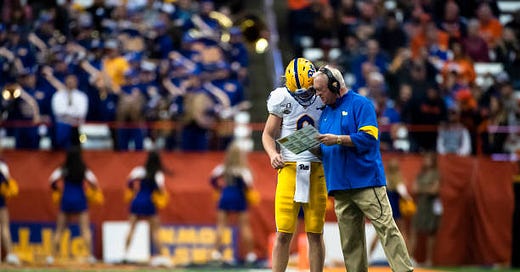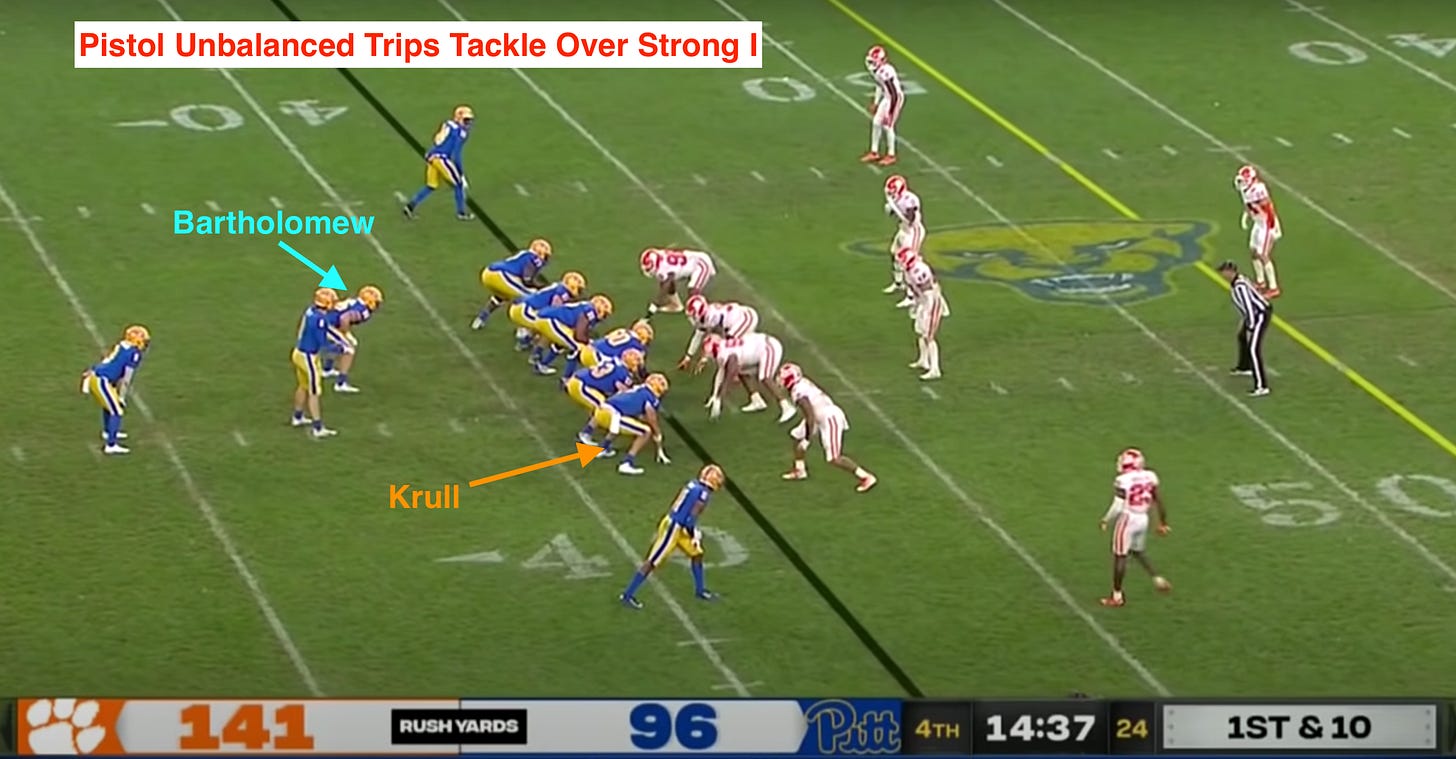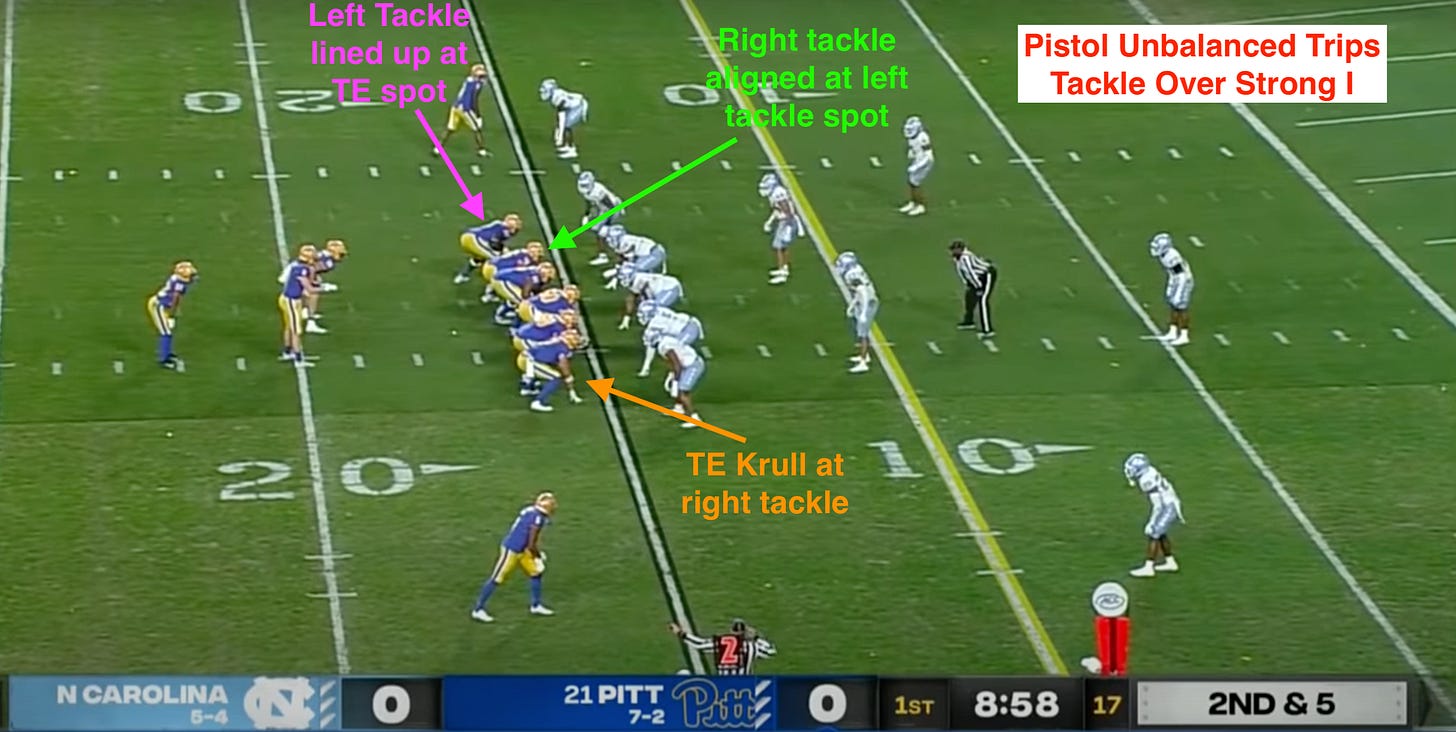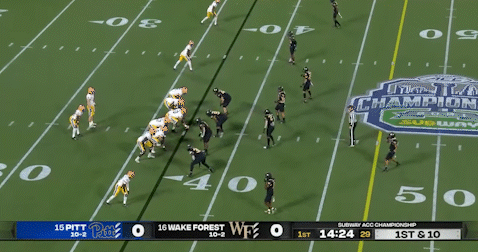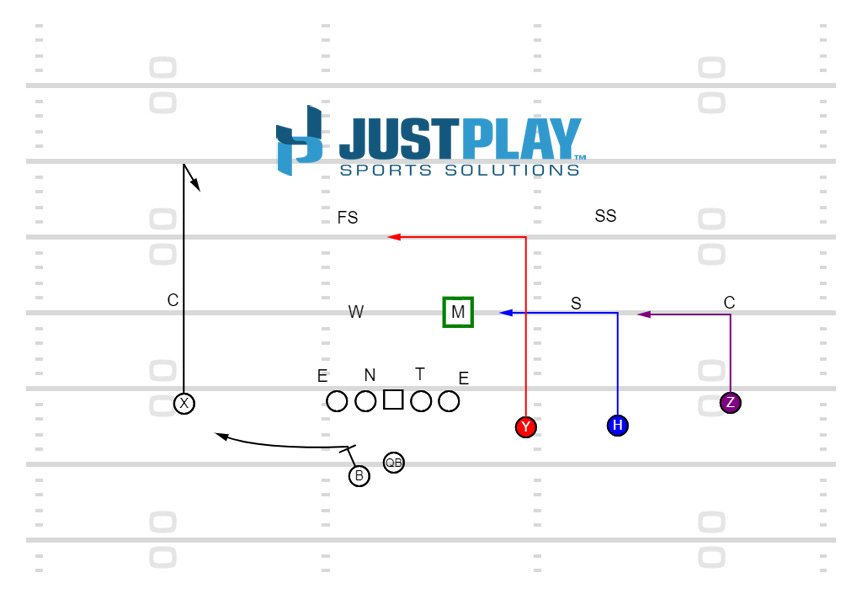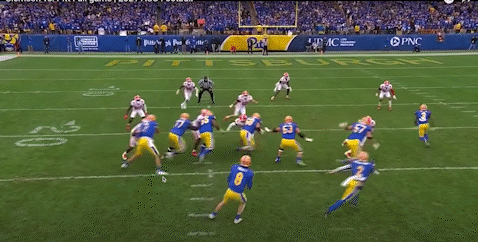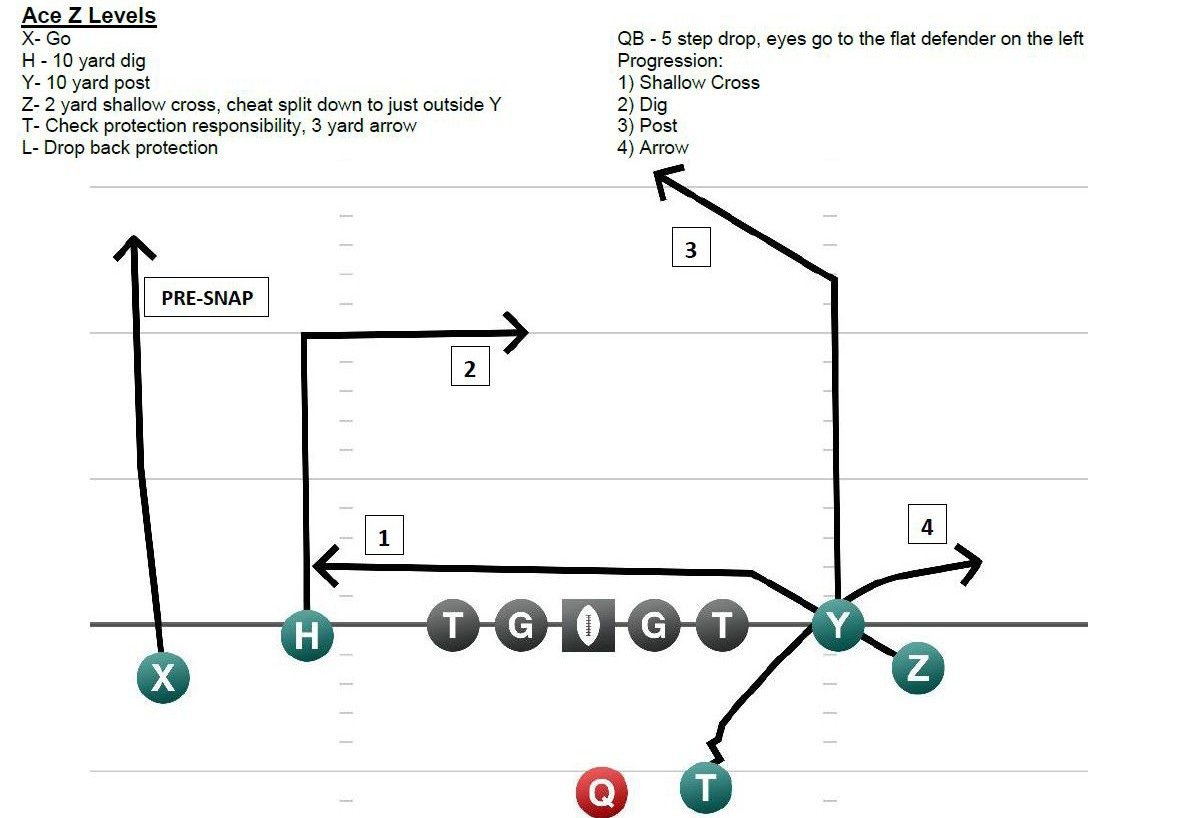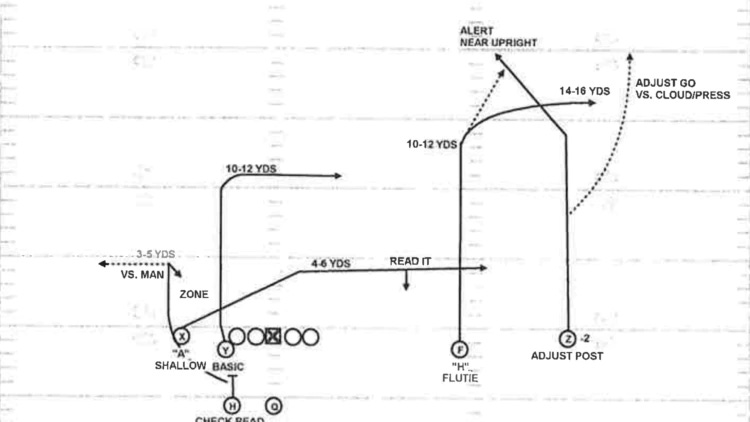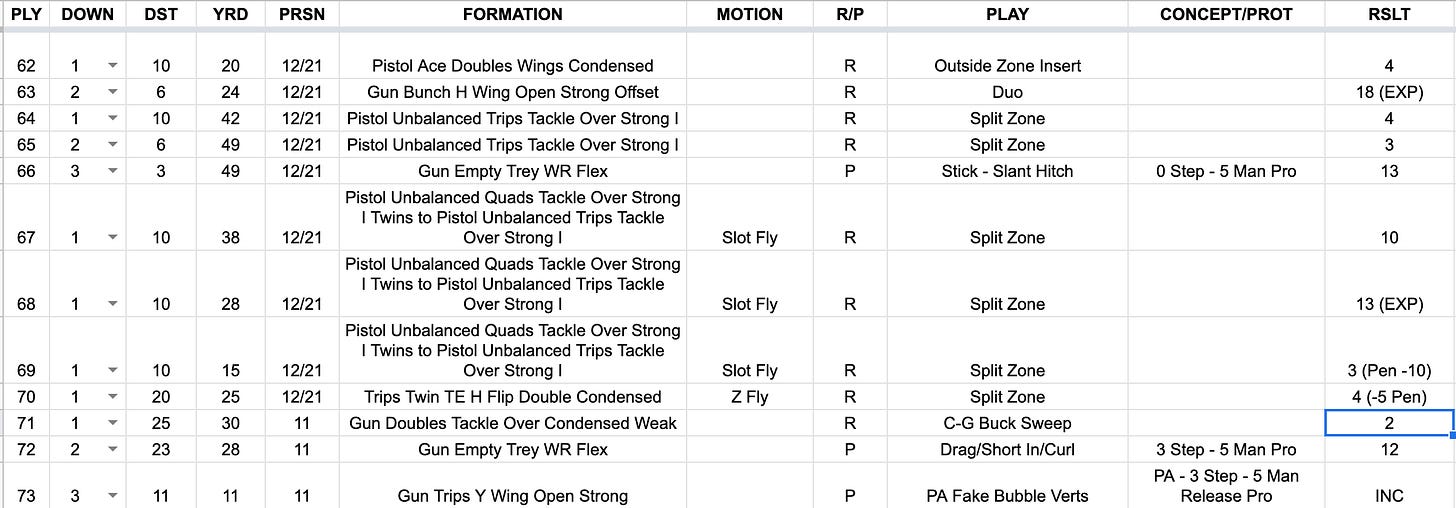Whipple SZN
The hiring of Nebraska's new offensive coordinator didn't make immediate sense on paper, but really how big of a departure is Mark Whipple's scheme?
**MICHAEL JORDAN VOICE**: “I’m back.”
It’s been several months since I dropped any Husker content in your inbox, but with the coaching staff and roster more solidified after the January/February turnover period and spring practice nearing completion, I think it’s possible to start making some informed speculation/assumptions about next year’s team. And even if this post isn’t informed speculation/assumptions, WILD AND OVERLY OPTIMISTIC HUSKER OFFSEASON HYPE is also something this newsletter fully embraces.
The biggest offseason change for Nebraska was the reboot of its offensive coaching staff and the hiring of a coordinator to take over play calling duties from head coach Scott Frost. The NU offense has not been as bad as some portions of the fanbase like to pretend it has been under Frost — it finished 33rd, 31st and 30th in schedule-adjusted efficiency per the three major statistical services last season — but it has also definitely not been the face-melting attack that was expected when he was hired. There also has been a pretty undeniable lack of player progression and development from the quarterback, running back, wide receiver and offensive line units; uncoincidentally, there are new coaches leading each of those position groups in 2022 (shoutout to tight ends Sean Beckton, whom I guess was the only person competently doing his job on the offensive staff for the last four years???)
Enter: Mark Whipple. Whipple, a two-time head coach of UMass and most recently the offensive coordinator at Pittsburgh, was not on many people’s offensive coordinator shortlists, and with his extensive NFL experience, East Coast history and propensity for LOVING THE HELL OUT OF THE FORWARD PASS, he would seem to be a not-immediately-obvious fit for a power spread coach in the Great Plains who just got done doubling down on the triple option. But Frost generally operates with some sensible, understandable motivations, and he knows offense, so there had to be more overlap than initially met the eye. To explore, I broke down three of Pittsburgh’s offensive games last year: a mid-season game against Clemson (excellent defense), a late-regular season game against North Carolina (bad defense) and a conference title game against Wake Forest (an atrocious defense). For Nebraska’s sample I used the last six games of Nebraska’s season minus the Iowa game where it played a backup quarterback (so the Northwestern through Wisconsin stretch) as that seemed to be where the offensive plan “solidified.” The Pittsburgh game logs are below and the Nebraska game logs can be found by going to the game posts in the newsletter's archive. I’ve broken the research into the categories of general tendencies; personnel and alignment; run and pass concepts; and playcalling.
CLEMSON AT PITTSBURGH: Google Sheets link / Downloadable PDF
NORTH CAROLINA AT PITTSBURGH: Google Sheets link / Downloadable PDF
PITTSBURGH VS. WAKE FOREST: Google Sheets link / Downloadable PDF
GENERAL TENDENCIES:
Some very obvious differences right away: Mark Whipple loves to SLING THAT THANG. I think it’s been understood and expected he was a pass-first coordinator and NU would throw more under him, but this is a very vast discrepancy and one I think is being underappreciated. Nebraska was one of the most run-heavy power-conference squads in the county last year and will now be transitioning to an offense led by a coordinator who wants to pass the ball more than almost anyone. Most power-conference offensive systems are somewhere in the 60-40 percent run/pass split in either direction, so Whipple’s pass usage here is a fairly significant outlier.
But more promising is that the rest of their general tendencies were fairly similar: The teams were even in how often they used RPOs, and Whipple likes to play with pace and uses plenty of motion. All of those things fit with what we know about Frost’s preferences. There is some overlap in the bones of the offense, even if the run/pass dials are going to be cranked in some different directions.
The pace levels are fairly interesting/surprising and possibly an underexplored reason Frost might have been drawn to a collaboration with Whipple. For all of the blur offense stuff Frost was supposed to bring from Oregon and UCF, NU actually played pretty slowly last year (likely trying to condense games against more talented teams), but Whipple actually DID have his offense move that fast. The 2021 Panthers were a lot closer to those classic Chip Kelly Oregon teams than 2021 Nebraska was.
First down pass rate is a useful indicator to tell how aggressive an offense is: A team that wants to play conservatively is going to try to run the ball to stay on schedule more often on first down, while an aggressive team is going to treat every possible down as a chance to get a big play. That Whipple was more on the conservative side is a little surprising and doesn’t fit with the rest of his M.O. But I think this data point might be a little skewed: In two of the three games I watched, Pitt had a pretty sizeable lead and was killing clock, while NU was playing from behind pretty frequently in the games I used as a sample. So I don’t know if I’d throw a ton of stock into this, but it is something to keep an eye on.
PERSONNEL/ALIGNMENT:
There are more similarities here than differences. Both teams worked primarily in 11 Personnel (one running back and one tight end) and sprinkled in some 12 Personnel (one back, two tight ends) and 21 Personnel (two backs, one tight end). Whipple has said he plans to use tight ends a little more frequently than NU did, which the numbers back up.
A MAJOR OVERLAP in the two offenses is their use of tight ends in varied roles, lining them up in typical tight end positions but also in split-out receiver spots in open doubles and trips formations and as H-backs. I talked about NU lining its tight ends up as “receivers” in traditional 10 and 11 Personnel formations to generate a blocking advantage on outside runs, RPOs and screens back in this newsletter’s very first post, and Whipple will do the same. Here are three plays from one drive against Clemson that Pitt ran without huddling or subbing, with the alignments of tight ends Lucas Krull and Gavin Bartholomew highlighted:
The second screenshot above is an “I-Formation out of the Pistol” package Whipple runs quite a bit. Nebraska used backfield blockers/H-backs sparingly, but this alignment is Whipple’s preferred look for running the ball and throwing play-action shots. One of the biggest drawbacks of the shotgun running game is that it forces a back to run side-to-side. Even on a downhill run concept like inside zone or duo, the back’s first step is always going to be lateral. This slows how quickly he can hit the hole and limits the effectiveness of certain concepts out of the shotgun.
Lining an H-back (in this case, Bartholomew) beside the quarterback in the Pistol creates a defacto old-school Strong or Weak I-Formation with a lead blocker and allows a spread/primarily Shotgun team to run under-center run concepts without having to actually snap from under center. So for the Husker fans who wanted the I-Formation and fullback back, you’ve (sort of) got it.
The other big two tight-end formational tendency to hit on: This dude LOVES unbalanced looks and to bring a tackle over. On 20.9% (!!!) of Pitt’s total offensive snaps, Whipple would move his right tackle to line up next to his left offensive guard, slide his left tackle to a traditional tight end alignment and put his tight end in the right tackle’s traditional spot:
Aligning like this gives you a blocking advantage to one side if you’re running — you now have three offensive lineman to one side instead of two offensive lineman and a tight end — and creates overall defensive confusion/thinking. It can be especially deadly if you’re throwing — the tight end is still an eligible receiver if the formation is unbalanced, and it’s a special set of coverage rules for “who is going to cover the right tackle in pass coverage” — and Whipple will release that tight end on routes on most of the plays. Whipple did this a lot out of the Pistol Strong/Weak I package (like in the diagram above) which can create an even bigger numbers advantage in the rushing game. But he also did it out of spread formations and other personnel groupings. If Pitt was in 10 Personnel (one running back and zero tight ends) and moving at tempo, he’d even do it by having his X receiver and line up in the tackle’s spot. Watch the receiver at left tackle release on a pass route:
I’m cackling. If you’ve ever wanted to see Omar Manning line up as an offensive lineman, have I got an offensive coordinator for you.
Additionally, having the “12” and “21” Personnel groupings be the same players allowed Whipple to not have to sub to switch between the looks, which let him play at pace and keep the defense off balance.
Here’s what that whole stretch from the Clemson game looked like:
The defense is seeing a traditional two tight end Ace look on the first play, before it morphs into a Strong I look, then to an Empty look that spreads everyone out, before getting back into the Strong I and ending with a traditional two-tight end look. Pitt would also use motion a lot out of its 12/21 package to switch between the alignments right before the snap. All while never huddling and moving at fast tempo.
Frost killed teams last year with a similar “varied tight end roles at tempo” package with Austin Allen and Travis Vokolek, so it’s not hard to imagine a slight tweak where Volkolek is now WRECKING DUDES as the “fullback” blocker out of the backfield in the Bartholomew role and Thomas Fidone (if healthy) is playing the Y before Nebraska moves at fast tempo and both split out to the slots to torment some poor base defense linebackers on routes in the open field.
When he wanted to spread it out, Whipple preferred Trey sets, open and closed, over traditional Trips, Trio or Bunch looks. “Trey” simply means that the No. 3 receiver to the trips side is the one on the ball, as opposed to the No. 1 receiver in a regular “Trips” set or the No. 2 receiver in a “Trio” look. “Trey Closed” — where the No. 3 receiver, typically a tight end, is connected to the offensive tackle — gives you all the passing benefits of a 3x1 alignment while also making the defense defend an extra gap in the running game, while “Trey Open” — where the No. 3 receiver is detached from the tackle — lets Whipple get into some of his West Coast passing concepts more easily and gives his outside receivers a little more space to beat any potential press coverages. Whipple especially liked to line speed-demon Biletnikoff Award winner Jordan Addison up at the #3 spot in Trey Wide formations to let him torch linebackers and safeties and put the bigger options like X Jared Wayne as the backside No. 1 to let him body up corners one-on-one:
(That alignment was a K.C. Chiefs staple with Tyreek Hill as the #3 [RIP] and Travis Kelce as the backside #1, FYI). When Whipple was in spread doubles, preferred an Open Flex set, with one of the No. 2 receivers on the ball:
Pitt was in a Trey or a Doubles Open Flex set on almost 34% of its plays in the sample I charted. Both formations are old staples of Air Raid offenses, which is interesting considering Whipple’s reputation as a “pro-style” guy. The Air Raid has slowly crept more and more into the NFL over the last decade, so I think this — plus his embrace of motion and tempo — is a sign his passing attack is maybe more modern/cutting edge than just some “cookie cutter NFL offense” as it’s been described and that he’s added to his repororie. It’s also promising because NU ran a good amount of these formations last year, so they shouldn’t be new to players.
One last thing: A pretty large misconception of Whipple’s offense I’ve seen is that his NFL background means he’s going to take NU under center more. That wasn’t true in 2021, at least, as he was in the Shotgun or Pistol nearly all the time aside from a handful of snaps each game.
RUSHING GAME:
This is the biggest difference in the offenses. Nebraska obviously prioritized running the ball much more heavily than Pitt last year, but NU also had a diverse and complex run package utilizing many concepts (sometimes to its detriment, in my opinion), whereas Pitt and Whipple basically just hammered the three zone plays and occasionally tossed in some basic gap-scheme stuff or draws/traps/outside sweeps to keep the defense honest. Nebraska also used its quarterbacks’ legs much more frequently on read and triple option concepts.
The good news is NU has run the concepts Whipple prefers quite a bit; split zone was a huge part of the Huskers option and RPO packages and has probably been repped a million times in practice. Nothing Whipple installs should be new; it may just be less in total that is installed.
I do think there is an argument that’s a good thing. The Husker run package has felt like a grab bag on occasion, with plays showing up and getting used a couple of times in one game before disappearing for weeks, like Down-C. In football, and especially with offensive line play, PRACTICE REPS ARE EVERYTHING. Splitting those practice reps over more total concepts is only going to limit how good you can be at each. “Diverse run game that is a nightmare for defenses to prepare for” is one of Frost’s best skills, so I still expect Nebraska’s run package to be diverse and hew closer to 2021 Nebraska than 2021 Pitt, but I do think there is some benefit to Whipple coming in and saying, “Let’s spend our practice time being really good at five concepts instead of trying to run eight concepts and ending up mediocre at all of them.”
I also still expect the quarterback run game to be a part of any Frost offense, and Whipple did run his QB some, but I also think diminishing the rushing workload on the quarterbacks would be smart. Aim for five designed QB runs a game instead of the 15 they were getting last year.
One final thing I noticed in the running game was Whipple’s RPO preferences. Where NU’s RPOs were a decent mix of pre-snap box count reads and post-snap movement reads, Pitt seemed to rely much more heavily on the former. Whipple’s RPOs were much more likely to be, “This overhang linebacker lined up in the box before the snap so automatically throw this bubble screen” than, “Evaluate this linebacker’s movement after the snap and make a split-second handoff-or-throw decision,” though he did run some of both types. Not wanting to run his quarterbacks likely played some role in that differenc.
PASSING GAME:
The most significant difference here is that Whipple used a lot less play action, which fits with him running the ball less overall. But basically every piece of data we have says that even token play-action is more effective than straight drop-back passing and is not correlated to success running the ball, so you’d like to see that dial increase closer to Frost’s level.
Trying to analyze passing routes beyond the first five yards on the standard TV feed is a nightmare (SIGN MY PETITION TO MAKE ALL GAMES BROADCAST IN ALL-22), but I was able to pick up on a few general tendencies and principles. A lot of Whipple’s offense was pretty standard West Coast/Bill Walsh stuff with modern bells and whistles. Beyond that, concept-wise, Whipple seemed to prefer a lot of ( a ) high-low and vertical stretch concepts over the middle to put linebackers in conflict; ( b ) route combinations with receivers breaking in the same direction; and ( c ) matchup-based combinations that allow the quarterback to pick between several receivers in a triangle based on who wins.
One of his favorite concepts — which uncoincidentally combines all three of the above tendencies — was Levels.
Levels is two short in-breaking routes, with a 10-yard in (or “Basic” route) behind it. In zone coverage, the middle linebacker (the “M” with the green square around it in the diagram above) is put in conflict by the Basic route and the shorter In routes: If they get depth to cover the Basic, the quarterback will hit one of the two short In routes right in front of them; if they come up to play the In routes, the ball gets thrown over their head to the Basic. In man, the quarterback reads based who “wins” against their defender from the Basic to the Ins to the backside route by the X. Here’s what it looked like when Pitt ran it:
Whipple also liked to sometimes turn the Basic into a Corner route as a curveball to the defense. This play below also is wide enough to show the backside route of the concept, which was either a deep curl or Dig route.
Levels was such a popular concept for Whipple that defenses keyed hard on it and his curveballs off it were very effective. Here he has the short Ins start inside before pivoting back out to the outside to catcg the defense off guard, while Addison fakes inside to make it look like a Basic route before breaking out into a Corner and destroying a Clemson safety:
Keep in mind that Whipple typically had Addison as the No. 3 in trips (the “Y” in the diagram above) running the Basic and a bigger, more physical receiver on the backside (the “X” in the diagram); it’s pretty easy to imagine guys like Trey Palmer, Alante Brown and Isaiah Garcia-Castenada eating on that Basic concept against slow Big Ten Mikes and bigger wideouts like Manning and Zavier Betts (if he’s still on the team) bodying corners on those backside digs and curls.
Other concepts Whipple smashed that work similarly were Shallow Cross and Drive. Both involve the quarterback reading a high-low on a linebacker and progressing to the back (basically reading a “triangle” in the middle of the field with the Basic, the Drag and the back’s release to the flat. Here are diagrams of the plays and clips of Pitt running them:
Gun Doubles Open WR Flex Condensed — Shallow Cross
In the play above, watch the linebacker standing near the middle of the formation run with Basic route from the slot receiver toward the bottom of the screen to clear space for the drag.
For more in-depth stuff on Shallow Cross and Drive, check out this very detailed post on Smart Football.
Some other concepts I saw Whipple run with some regularity were Smash, Mesh, 989 and big clearout Drag looks. He also had more designery stuff and curveballs off of these, as well as more advanced down-the-field concepts, but it’s hard to get a totally confident sense of down-the-field passing game if the TV camera doesn’t let you see past 10 yards, so I don’t feel super authoritative talking about those. I did see some deep crossing patterns that NU liked a lot last year.
Overall, I wouldn’t say the transition to Whipple’s passing attack is THAT stark?Levels, Shallow Cross, and Drive ARE all pretty classic West Coast fare, but they’ve also been adopted by the Air Raid, which is where Frost seems to have gone recently with some of his passing game. Nebraska also hammered Smash, Mesh and Drag concepts last year. So not a lot of this should be new. There are always differences in how a coach might teach the concepts or the rules they might have, but NU receivers and quarterbacks should have reps running these concepts.
There were some similarities in protection, too. Both teams relied primarily on five-man protections with a back or tight end checking on blitzers before releasing (NU’s backs typically released into the flat; Pitt’s typically released into the flat or on a short curl). I also saw Pitt utilizing the center and guard pulling on play action that NU frequently used last year with Cam Jurgens.
PLAY CALLING/SEQUENCING
One thing I noticed with Whipple was his willingness to repetitively call concepts if they were working or a defense couldn’t stop them. At one point against Clemson, he called Split Zone six times on one 12-play drive when the Tigers couldn’t stop it.
I know it’s a point of frustration for fans at times when a coach gets away from thing that are working. You don’t really have to worry about that from what I’ve seen from this guy.
I also wanted to mention this: To signal in offensive plays to the players, Whipple had his quarterback run over to the sidelines, yelled the play at them and then the quarterback went back to the offense and yelled it at them. He was apparently very worried about sign stealing and liked talking to the quarterback before each play. THIS STILL SEEMS INSANE TO ME?? It’s 2022! One of the things I will be watching for most in the spring game is to see if this continues: Does Whipple keep doing this, or is he forced to adapt to Nebraska’s in-place signalling apparatus?
CONCLUSIONS
Before I started this project, I had thought this was going to be a pretty drastic overhaul. But on a deeper dive, I came away feeling as if the bones of these two attacks are similar: from the tempo, to the preference for playing out of the Shotgun and Pistol, to the creativity/variability with tight ends, to the reliance on a zone running scheme, to the overlap in protection schemes and passing concepts. I think it’s pretty safe to say NU will pass A LOT MORE, and with that will come some inevitable uncomfortability and growing pains. But Whipple and Frost seem to have pretty similar ideas about offensive football, and there’s plenty of overlap on what concepts Nebraska players have been practicing for the last four seasons; this is not the “flexbone transitioning to the West Coast system” NU went through in the early 2000s under Bill Callahan. It’s not hard to imagine a productive marriage of these two offenses, with Frost designing the run game and making overall input during the week and Whipple handling the pass concepts and pulling the play-calling strings. I’m stoked!
What do you think? Do you hate the hire?? What would you like to see more of from Nebraska’s offense in 2022??? Are you happy with the more pass-happy direction the unit seems to be heading???? Why won’t NU get back to running the triple option????? Sound off in the comments below.
PROGRAMMING NOTE: For anyone who’s interested, Substack has an app in the Apple store now and you can get BLACK 41 FLASH REVERSE delivered there!
I have been trying it out for a week or so for the other newsletters I subscribe to and would recommend it! Gifs and videos play much better on it, and, best of all, there’s no email filters sending things to spam or cutting off text. It’s a better reading experience and easier for organization because things tend to get buried in my inbox and I forget about them. The app is only available for Apple devices currently, but you can join the Android waitlist here.


